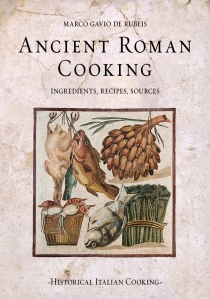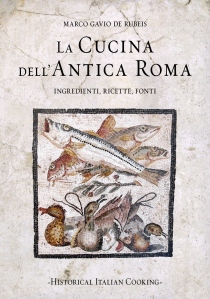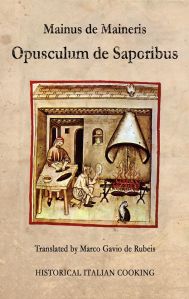English
UPDATE. We are pleased the release of our new book, Early Italian Recipes. Cereals, bread, pasta, and pies, in both e-book and print editions. You can find the Italian edition here.
The book includes a historical introduction about the use of the cereals throughout history, starting from Greek and Roman antiquity to reach the Renaissance and early modern period, using only primary sources, with an explanation of the various preparations, from puls and polenta to pasta, bread, pizza, and the different types of historical pies such as torta, pastello and coppo.
Among the 114 recipes, you will find preparations for bread ranging from the 7th century BCE to the 16th century, and methods for pasta starting from ancient Rome and Greece with lagana and tracta to typical medieval and Renaissance dishes such as lasagne, tria, vermicelli, gnocchi, maccaroni, ravioli, tortelli, and much more.
This volume is the second in the Early Italian Recipes series. The first, published in 2022, was dedicated to vegetables, fruit, herbs, and flowers in the history of Italian cuisine. The series will continue in the coming years with other books that will cover historical recipes for meat, fish, sweets, and beverages.
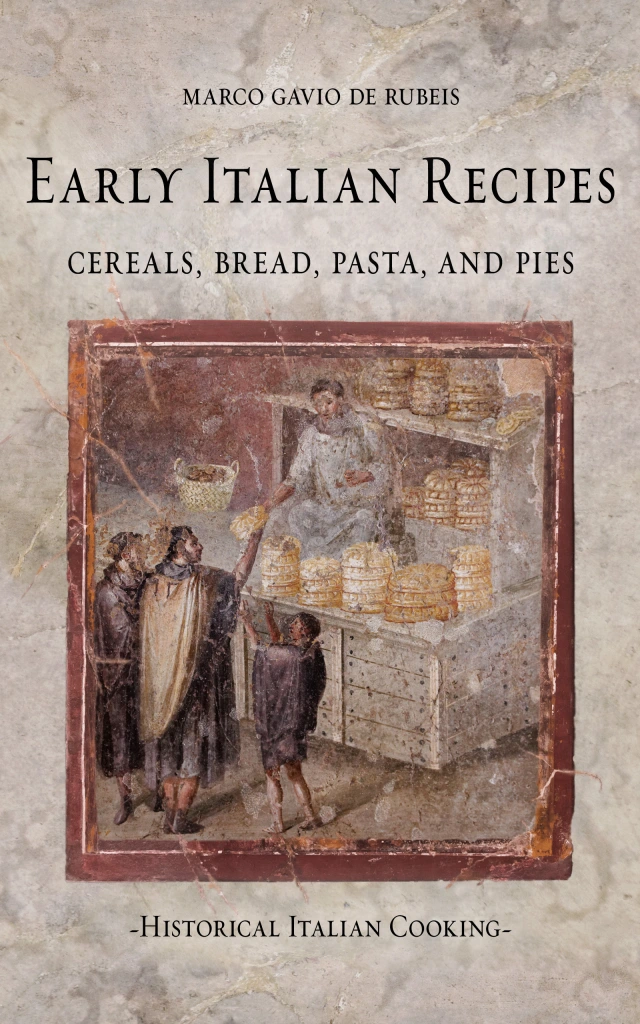
—
UPDATE. Our new book, Libro de la Cocina. Medieval Tuscan Recipes, is available on Amazon in print and e-book editions, in English and Italian. Written in Tuscan vernacular in the 14th century, this cookbook contains 175 easy recipes for all kinds of medieval dishes, from pasta and pies to meat, fish, and vegetables. Our translation is accompanied by an introduction, notes, and a glossary.
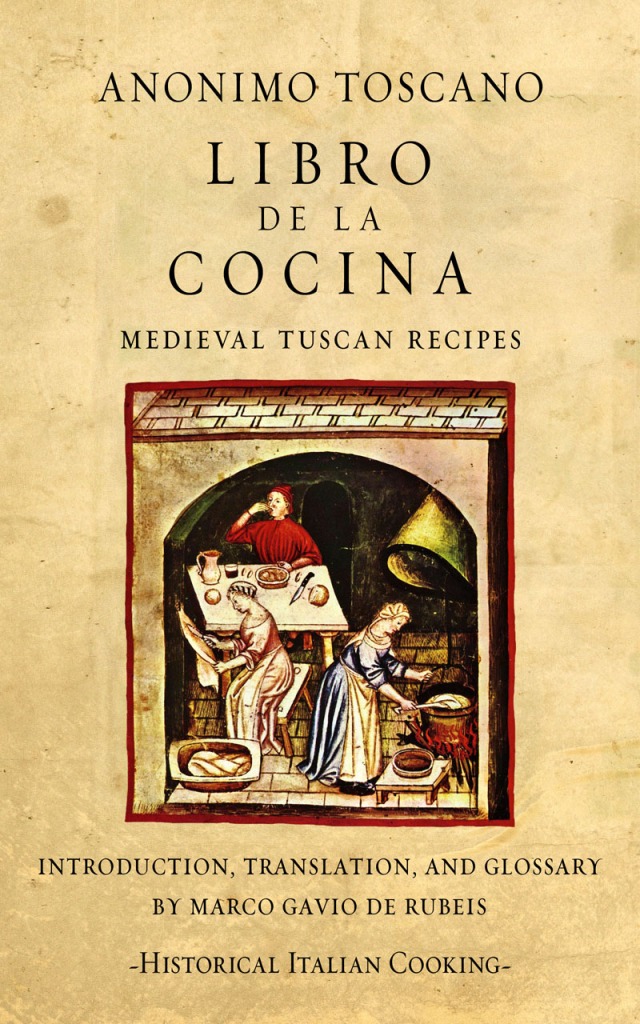
Written in the 14th century by an anonymous Tuscan author, the Libro de la Cocina is one of the first cookbooks in Italian vernacular and records the beginning of a culinary tradition that still survives today in many recipes of Central Italy, especially Umbria and Tuscany.
Creative and colorful with many vegetables, spices, and herbs, this book shows us a whole world of recipes for meat, fish, pasta, pies, and other dishes with variants for the fat and lean days, with plenty of details and suggestions that make it a complete handbook essential to understand the principles at the basis of medieval cuisine and learn how to create authentic, historical plates. With its 175 recipes, the Libro de la Cocina is one of the most interesting medieval cookbooks, simple to follow and practice, perfect for our journey into history through the origin of Italian cooking.
To make this source easier to read, we accompanied our translation with notes that compare the text with others written in the same period, in particular the Liber de Coquina, a glossary, and an introduction about the ingredients and preparations, which includes an explanation of the basic methods taken for granted by the medieval author.
UPDATE.
Our new book, Early Italian Recipes. Vegetables, fruit, herbs, and flowers, is available on Amazon in print and e-book editions, in English and Italian. It is the first of a series of books that explore the history of Italian cuisine through specific ingredients and preparations. In the next years, we will publish further books on cereals (pasta, bread, and pies), meat, fish, sweets, and beverages, in addition to translations of historical sources from the Antiquity to the Middle Ages (such as Registrum Coquine. A medieval cookbook and De Observatione Ciborum. Early-medieval recipes at the court of the Franks, published in 2021).

Colorful and full of flavors, Italian cuisine is characterized from its origin by a substantial use of wild and cultivated herbs, vegetables, legumes, but also fruit and flowers, which appear not only in recipes for sweets but also in savory dishes.
Our book is divided into two parts: the first is a historical introduction; the second collects several recipes taken from sources on cooking, dietetics, and agronomy from the Antiquity to the beginning of the Modern Era. In the introduction, we explore the philosophical and religious basis of the consumption of vegetable ingredients, in particular the Pythagorean diet and the practice of the lean days in the Middle Ages and Renaissance; then, we examine the preparation of salads, considered a staple of the Italian diet, described by physicians, cooks, and naturalists; finally, we gave a series of practical suggestions about the basic recipes and ingredients, in particular how to substitute the ones most difficult to find.
The second part includes various preparations, among which recipes completely excluding dairy products and eggs, for soups salads, sauces, stews, fritters, and other dishes, with all kinds of vegetables and legumes, some of which used today mainly in some regional traditions, through a journey back in the past to restore an amazing cultural heritage that deserves to be rediscovered.
UPDATE. It is available on Amazon our new book De Observatione Ciborum. Early-medieval recipes at the court of the Franks, in English and Italian. Written in the 6th century by the Byzantine physician Anthimus as a letter to Theuderic, the king of the Franks, De Observatione Ciborum is one of the earliest medieval sources on cooking and dietetics written in Latin, which shows the moment of passage between ancient and medieval traditions, with a focus on the foods and beverages used by the Franks. In our book, like in the previous Registrum Coquine. A medieval cookbook, you will find not only the translation of this text but also an introduction that puts Anthimus’ work into context and a glossary with the peculiar Latin used by this non-native author.
The book is available in e-book and printed editions.
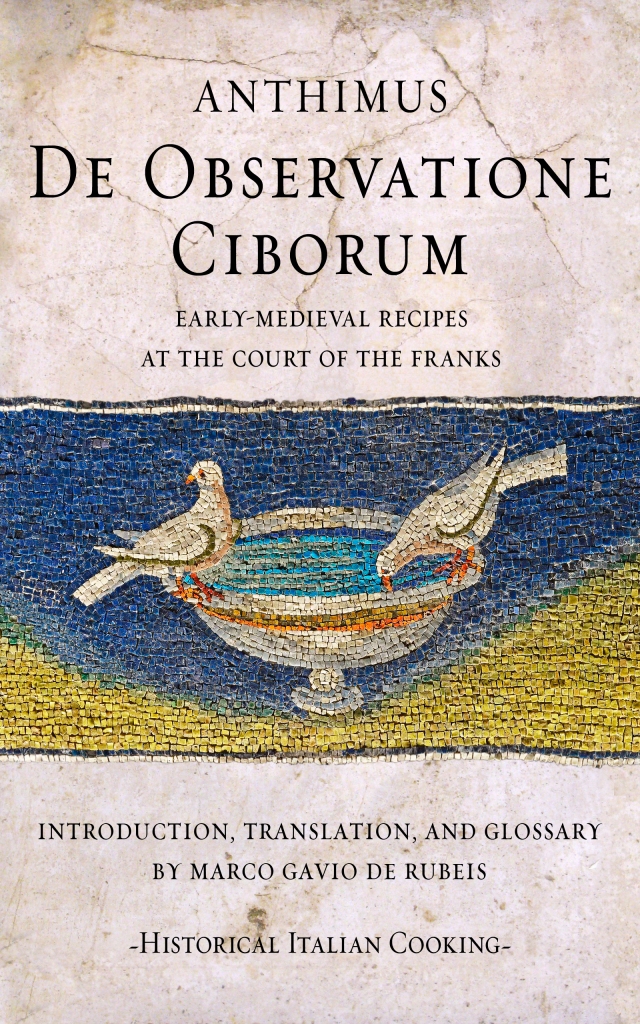
“Halfway between a dietetic treatise and a cookbook, De Observatione Ciborum was written in the 6th century by the Byzantine physician Anthimus as a letter to Theuderic, the king of the Franks. Through the descriptions of the aliments, their properties, and the healthiest methods to prepare them, Anthimus shows the uses of the Franks, revealing the differences between them and the Mediterranean peoples and at the same time the similarities, especially in the language and traditional foods and beverages such as tesana, melca, wormwood wine, laredum, or mead, and recording the passage from a culinary culture based on olive oil to one that prefers animal fats.
De Observatione Ciborum is a fascinating reading, in which a peculiar Latin is used as a lingua franca between two non-native speakers, a source that allows the enthusiast of food history to catch a glimpse of a fundamental cultural metamorphosis and understand how the ancient traditions will transform throughout the centuries to become something new though deeply rooted in the past.”
UPDATE. It is available for pre-order on Amazon our new book about medieval cooking, with the translation of a beautiful 15th-century cookbook written by Johannes Bockenheim, the Registrum Coquine. It will be out on the 10th of June in e-book and printed edition, in English and Italian.

Written in the 15th century by the German ecclesiastic Johannes Bockenheim, cook under Pope Martin V, the Registrum Coquine is one of the most interesting and funny medieval cookbooks.
In the text, collected into two manuscripts, we find more than 80 recipes for prostitutes and actors, princes and peasants, pimps and priests, kings and mercenaries, in a colorful representation of the complexity of medieval society, more layered and rich than we commonly imagine.
A fascinating world made of spices, flavors, preparations forgotten through time and worth to be discovered again, theoretically and practically in our kitchens.
From Marco Gavio de Rubeis, author of Ancient Roman Cooking. Ingredients, Recipes, Sources, a new book dedicated to the Registrum Coquine, with a translation with notes about the recipes and the differences between the manuscripts, in addition to an introduction about foods and ingredients across the social classes in the Middle Ages and a glossary of the terms used by Bockenheim, quite different from classical Latin and frequently more similar to the vernaculars spoken in Italy.
—
UPDATE. It is available on Patreon the second and last part of De Flore Dietarum, a beautiful dietetic source dating back to the 11th century, and the third book of De Re Coquinaria, in addition to the first two already published. With its 57 recipes, it is one of the most interesting of the cookbook that the tradition attributes to Marcus Gavius Apicius, Caelius Apicius in the Renaissance editions. It is titled Cepuros, a word that probably wants to recall the Greek term kepos, which means garden: this book, indeed, is entirely dedicated to vegetables and fruit, some of them quite uncommon at our times, at least in Italy.
In addition to this translation, you find on Patreon the e-books of other sources: the first part of Anonimo Veneziano (14th century), De Flore Dietarum – second part here (11th century), Appendicula de Condituris Varis (8h or 9th century), Opusculum de Saporibus by Mainus de Maineris (14th century) and the complete text of the Registrum Coquine by Johannes Bockenheim (15th century) – second part here. The Registrum Coquine is also available to pre-order on Amazon.
—
UPDATE. This month on Patreon it is available in translation the first part of De Re Coquinaria, a massive collection of ancient Roman recipes divided into ten books, which the tradition attributes to Marcus Gavius Apicius, with more than 60 recipes. This issue includes Epimeles, a book entirely dedicated to the preserves, with many suggestions, for example, about how to prepare mulled wines or aromatized salt, how to improve garum and honey, or why we have to use fava-bean flour as an additive for wine, as well as how to keep fruit and vegetables or prepare the most common sauces. The second book, instead, is called Sarcoptes and collects several recipes for meatballs, fish cakes, and sausages.
In addition to this translation, you find on Patreon the e-books of other sources: the first part of Anonimo Veneziano (14th century), De Flore Dietarum (11th century), Appendicula de Condituris Varis (8h or 9th century), Opusculum de Saporibus by Mainus de Maineris (14th century) and the complete text of the Registrum Coquine by Johannes Bockenheim (15th century) – second part here.
—
UPDATE. On Patreon, you find this month the translation of the first part (out of three) of Anonimo Veneziano’s manuscript, dating back to the end of the 14th century and written in Venetian vernacular. It is a beautiful cookbook that shows all the magnificence of the cuisine in a late medieval court. The first part includes 44 recipes.
This is the fifth source we translated for our Patrons, in addition to De Flore Dietarum (11th century), Appendicula de Condituris Varis (8h or 9th century), Opusculum de Saporibus by Mainus de Maineris (14th century) and the complete text of the Registrum Coquine by Johannes Bockenheim (15th century) – second part here.
—
UPDATE. If you want to help us, you can now buy us a beer or our merchandise.
A new translation (in English and Italian) is available on our Patreon page, with the first part of De Flore Dietarum, a book of dietetics written in the 11th century and belonging to the tradition of the Salernitan Medical School. The text is divided into two parts: the first, very short but thick with contents, explains the theoretical and philosophical basis; the second, instead, describes every kind of food and beverage according to the principles previously illustrated. Some entries are quite long, others just quick annotations. This second part is easier to read than the first and contains also a few recipes and suggestions about the methods to cook the foods.
This is the fourth source we translated for our Patrons, in addition to the Appendicula de Condituris Varis, the Opusculum de Saporibus by Mainus de Maineris (14th century) and the complete text of the Registrum Coquine by Johannes Bockenheim (15th century) – second part here.
—
UPDATE. New translation in English and Italian on our Patreon page: a beautiful source written in the 8th or 9th century by Johannes Damascenus, dedicated to fruit and root preserves. There you find, for example, how to make compotes with ginger, parsnip, citrus, and nuts. The Appendicula de Condituris Varis is the third translation we published, with the Opusculum de Saporibus by Mainus de Maineris (14th century) and the first part of the Registrum Coquine by Johannes Bockenheim (15th century).
—
UPDATE. Our new book, “Ancient Roman Cooking. Ingredients, Recipes, Sources“, is available to pre-order on Amazon. Here you find the Italian edition.
“Ancient Roman gastronomy was famous for an incomparable skill in the art of pairing the ingredients, with its Mediterranean flavors and healthy balance among the aromas.
Many sources record the greatness of Roman cuisine. Writers and poets celebrate its beauty, complexity, decadence, and at the same time, its simplicity. Agronomists tell the life in the countryside, showing the farming techniques and the preparation of common preserves, from cured meat to cheese, vegetables, fruit. Cooks focus on providing unique sensorial experiences through the learned use of ingredients that belong to our history, now almost forgotten. Silphium, garum, mulsum, allec, sapa are just some of them.
A journey back in time through ingredients and recipes, from the republican age to the empire, to rediscover an extraordinary culinary tradition that will satisfy, still today, the most refined palates.”
—
UPDATE. On our Patreon page, you find the translations into English and Italian of the Opusculum de Saporibus by Mainus de Maineris (14th century) and the first part of the Registrum Coquine by Johannes Bockenheim (15th century).
—
Welcome, readers!
In this blog you will find information about Italian cooking throughout the centuries with videos, recipes, and articles about ingredients, books, and food culture of our country. Our sources are the many cookbooks saved over two millennia, starting from ancient Rome, crossing Middle Ages and Renaissance, and reaching the Modern Era.
Here you will find historical sources and how you can prepare the courses in a philological and tasty way, with our interpretation of the texts and suggestions.
This blog is born from years of study, both theoretical and practical, about early cooking, and from the questions our audience asked us about how to prepare the dishes or to substitute rare ingredients. In this time, we published a few books about historical cooking with the no-profit organization I Doni delle Muse, using the collective pen name Marco Gavio de Rubeis. We intend to translate them soon into English.
We hope you’ll appreciate our work, in particular, because Italian cooking is more than the dishes all of us know. It is a world made of forgotten traditions, spices and flavors which seems to us extraordinarily complex and fascinating.
